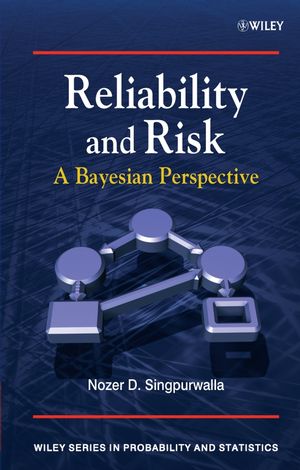Reliability and Risk: A Bayesian PerspectiveISBN: 978-0-470-85502-7
Hardcover
376 pages
September 2006
 This is a Print-on-Demand title. It will be printed specifically to fill your order. Please allow an additional 15-20 days delivery time. The book is not returnable.
|
||||||
Acknowledgements.
1 Introduction and Overview.
1.1 Preamble: What do ‘Reliability’, ‘Risk’ and ‘Robustness’ Mean?
1.2 Objectives and Prospective Readership.
1.3 Reliability, Risk and Survival: State-of-the-Art.
1.4 Risk Management: A Motivation for Risk Analysis.
1.5 Books on Reliability, Risk and Survival Analysis.
1.6 Overview of the Book.
2 The Quantification of Uncertainty.
2.1 Uncertain Quantities and Uncertain Events: Their Definition and Codification.
2.2 Probability: A Satisfactory Way to Quantify Uncertainty.
2.3 Overview of the Different Interpretations of Probability.
2.4 Extending the Rules of Probability: Law of Total Probability and Bayes’ Law.
2.5 The Bayesian Paradigm: A Prescription for Reliability, Risk and Survival.
Analysis.
2.6 Probability Models, Parameters, Inference and Prediction.
2.7 Testing Hypotheses: Posterior Odds and Bayes Factors.
2.8 Utility as Probability and Maximization of Expected Utility.
2.9 Decision Trees and Influence Diagrams for Risk Analysis.
3 Exchangeability and Indifference.
3.1 Introduction to Exchangeability: de Finetti’s Theorem.
3.2 de Finetti-style Theorems for Infinite Sequences of Non-binary Random.
3.3 Error Bounds on de Finetti-style Results for Finite Sequences of Random.
4 Stochastic Models of Failure.
4.1 Introduction.
4.2 Preliminaries: Univariate, Multivariate and Multi-indexed Distribution Functions.
4.3 The Predictive Failure Rate Function of a Univariate Probability Distribution.
4.4 Interpretation and Uses of the Failure Rate Function – the Model Failure Rate.
4.5 Multivariate Analogues of the Failure Rate Function.
4.6 The Hazard Potential of Items and Individuals.
4.7 Probability Models for Interdependent Lifelengths.
4.8 Causality and Models for Cascading Failures.
4.9 Failure Distributions with Multiple Scales.
5 Parametric Failure Data Analysis.
5.1 Introduction and Perspective.
5.2 Assessing Predictive Distributions in the Absence of Data.
5.3 Prior Distributions in Chance Distributions.
5.4 Predictive Distributions Incorporating Failure Data.
5.5 Information from Life-tests: Learning from Data.
5.6 Optimal Testing: Design of Life-testing Experiments.
5.7 Adversarial Life-testing and Acceptance Sampling.
5.8 Accelerated Life-testing and Dose–response Experiments.
6 Composite Reliability: Signatures.
6.1 Introduction: Hierarchical Models.
6.2 ‘Composite Reliability’: Partial Exchangeability.
6.3 Signature Analysis and Signatures as Covariates.
7 Survival in Dynamic Environments.
7.1 Introduction: Why Stochastic Hazard Functions?
7.2 Hazard Rate Processes.
7.3 Cumulative Hazard Processes.
7.4 Competing Risks and Competing Risk Processes.
7.5 Degradation and Aging Processes.
8 Point Processes for Event Histories.
8.1 Introduction: What is Event History?
8.2 Other Point Processes in Reliability and Life-testing.
8.3 Multiplicative Intensity and Multivariate Point Processes.
8.4 Dynamic Processes and Statistical Models: Martingales.
8.5 Point Processes with Multiplicative Intensities.
9 Non-parametric Bayes Methods in Reliability.
9.1 The What and Why of Non-parametric Bayes.
9.2 The Dirichlet Distribution and its Variants.
9.3 A Non-parametric Bayes Approach to Bioassay.
9.4 Prior Distributions on the Hazard Function.
9.5 Prior Distributions for the Cumulative Hazard Function.
9.6 Priors for the Cumulative Distribution Function.
10 Survivability of Co-operative, Competing and Vague Systems.
10.1 Introduction: Notion of Systems and their Components.
10.2 Coherent Systems and their Qualitative Properties.
10.3 The Survivability of Coherent Systems.
10.4 Machine Learning Methods in Survivability Assessment.
10.5 Reliability Allocation: Optimal System Design.
Systems.
10.6 The Utility of Reliability: Optimum System Selection.
10.7 Multi-state and Vague Stochastic Systems.
11 Reliability and Survival in Econometrics and Finance.
11.1 Introduction and Overview.
11.2 Relating Metrics of Reliability to those of Income Inequality.
11.3 Invoking Reliability Theory in Financial Risk Assessment.
11.4 Inferential Issues in Asset Pricing.
11.5 Concluding Comments.
Appendix A Markov Chain Monté Carlo Simulation.
A.1 The Gibbs Sampling Algorithm.
Appendix B Fourier Series Models and the Power Spectrum.
Appendix C Network Survivability and Borel’s Paradox.
Bibliography.
Index.



